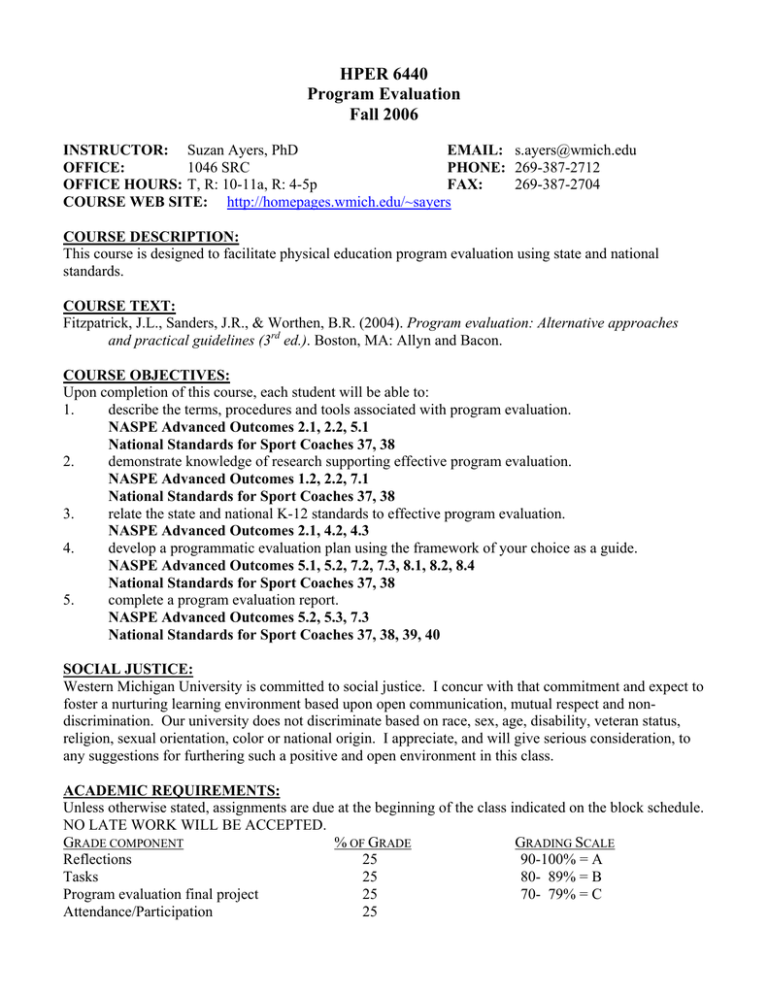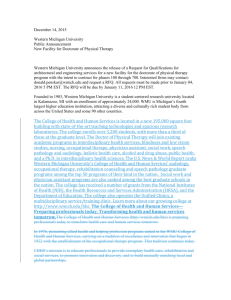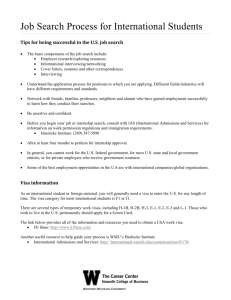HPER 6440 Program Evaluation Fall 2006
advertisement

HPER 6440 Program Evaluation Fall 2006 INSTRUCTOR: Suzan Ayers, PhD EMAIL: s.ayers@wmich.edu OFFICE: 1046 SRC PHONE: 269-387-2712 OFFICE HOURS: T, R: 10-11a, R: 4-5p FAX: 269-387-2704 COURSE WEB SITE: http://homepages.wmich.edu/~sayers COURSE DESCRIPTION: This course is designed to facilitate physical education program evaluation using state and national standards. COURSE TEXT: Fitzpatrick, J.L., Sanders, J.R., & Worthen, B.R. (2004). Program evaluation: Alternative approaches and practical guidelines (3rd ed.). Boston, MA: Allyn and Bacon. COURSE OBJECTIVES: Upon completion of this course, each student will be able to: 1. describe the terms, procedures and tools associated with program evaluation. NASPE Advanced Outcomes 2.1, 2.2, 5.1 National Standards for Sport Coaches 37, 38 2. demonstrate knowledge of research supporting effective program evaluation. NASPE Advanced Outcomes 1.2, 2.2, 7.1 National Standards for Sport Coaches 37, 38 3. relate the state and national K-12 standards to effective program evaluation. NASPE Advanced Outcomes 2.1, 4.2, 4.3 4. develop a programmatic evaluation plan using the framework of your choice as a guide. NASPE Advanced Outcomes 5.1, 5.2, 7.2, 7.3, 8.1, 8.2, 8.4 National Standards for Sport Coaches 37, 38 5. complete a program evaluation report. NASPE Advanced Outcomes 5.2, 5.3, 7.3 National Standards for Sport Coaches 37, 38, 39, 40 SOCIAL JUSTICE: Western Michigan University is committed to social justice. I concur with that commitment and expect to foster a nurturing learning environment based upon open communication, mutual respect and nondiscrimination. Our university does not discriminate based on race, sex, age, disability, veteran status, religion, sexual orientation, color or national origin. I appreciate, and will give serious consideration, to any suggestions for furthering such a positive and open environment in this class. ACADEMIC REQUIREMENTS: Unless otherwise stated, assignments are due at the beginning of the class indicated on the block schedule. NO LATE WORK WILL BE ACCEPTED. GRADE COMPONENT % OF GRADE GRADING SCALE Reflections 25 90-100% = A Tasks 25 80- 89% = B Program evaluation final project 25 70- 79% = C Attendance/Participation 25 HPER 6440 Fall 2006 2 ACADEMIC INTEGRITY/DISHONESTY: Academic honesty is central to WMU’s educational mission. It enables each of us to fulfill our potential, learn effectively with and from one another, acquire specialized knowledge and skills, become informed, responsible and creative thinkers and have pride in our institution’s standing. To these ends I require that students in this class represent their own work accurately and truthfully without cheating, fabrication, falsification or forgery, multiple submission, plagiarism, complicity and computer misuse, according to the policies in WMU’s Student Code that pertain to Academic Integrity (Graduate Catalog (pp. 26-28). If there is reason to believe you have been involved in academic dishonesty you will be referred to the Office of Student Conduct. You will be given an opportunity to review the charge(s). If you believe you are not responsible you will have the opportunity for a hearing. This particular class includes several take-home and group/partner assignments. Although you may discuss these with others in this class, the final answers that you turn in for grading must be written independently by you, and reflect your own efforts, knowledge, understanding and expression of ideas. If you have questions or are confused about what is or is not appropriate regarding this, or other issues of academic integrity, please consult with me during office hours or after class. I am available at those times to discuss anything pertaining to this course. The WMU Writing Center can give you additional help with paraphrasing and citing sources correctly. If you observe other students in this class engaging in any form of academic dishonesty I invite you to approach me in confidence about it. ASSIGNMENT DESCRIPTIONS Reflections: Assigned readings will require summaries synthesizing main points, personal opinions and reasoned consideration of authors’ statements. Details for the expectations of these summaries are available on the course web site. Tasks: You will be creating an evaluation plan that would have meaning for you and your organization or employer. Consider a program with which you are familiar. If you are at a loss for program you know, you might select your graduate program or some highly publicized program being considered by local or state officials. Using the program that you have selected, begin to complete each of these tasks: 1. Audience/stakeholders. Who would be the audiences/stakeholders for the evaluation of this program? Duplicate and complete the worksheet in figure 11.1 before answering the following questions to identify potential audiences/stakeholders: (a) Whom might you choose to interview? (b) What might be the perspectives of each person/group? (c) Should some representatives of the audiences/stakeholders be invited to serve as an advisory committee for the evaluation? (d) If yes, whom would you select and why? Be prepared to discuss how your information would relate to items A1-5 on the Evaluation Design Checklist (EDC): http://www.wmich.edu/evalctr/checklists/evaldesign.pdf. 2. Focusing the Evaluation. Develop (1) a list of purposes and (2) organization characteristics that could potentially serve as focal points for evaluation. Use items A6-15 on the EDC to guide your lists: http://www.wmich.edu/evalctr/checklists/evaldesign.pdf. 3. Evaluation Questions and Criteria. Using what you now know about generating and then selecting questions, criteria, and standards for the evaluation, generate: (1) a divergent “laundry” list of evaluation questions (10 minimum) you would want to address and (2) a convergent list, from those identified on laundry list, of critical questions (5 minimum). Duplicate and complete figure 12.2 to select the convergent list of questions. Be sure to identify the criteria and any standards used to identify evaluation questions. 4. Planning Evaluation. Using the evaluation questions you developed in #3, develop an evaluation and management plan to address those questions. What further information do you need to do that? What stakeholders should you involve in the planning the design? What tasks are involved in each step and who HPER 6440 Fall 2006 3 should do them? When should these tasks be completed? Complete items B1-10 on the EDC to develop your plan: http://www.wmich.edu/evalctr/checklists/evaldesign.pdf. 5. Quantitative Information. Recheck your evaluation plan as developed in #4. Are there plans you would like to change, using what you have learned about quantitative information? Would you want to add procedures, approach things a little differently? Use items C1-3 on the EDC to guide your ideas and items D1-12 to address analysis issues: http://www.wmich.edu/evalctr/checklists/evaldesign.pdf. 6. Qualitative Information. Have you included qualitative methods in your evaluation plan? Are there some you would add? If so, why? Use items C1-3 on the EDC to guide your ideas and items D1-12 to address analysis issues: http://www.wmich.edu/evalctr/checklists/evaldesign.pdf. 7. Reporting evaluation information. Use items E1-7 on the EDC to guide your report development: http://www.wmich.edu/evalctr/checklists/evaldesign.pdf. 8. Political, ethical, interpersonal aspects. Identify 3 people who might conduct the evaluation: one who closely associated with whatever you have selected to evaluate, one who works within the same organization but not closely associated, and one who would be considered external. Determine how much you believe each individual’s beliefs and relationships (with the object to study) would bias the evaluation. Do you think you would be appropriate to evaluate it? Why or why not? Program evaluation project: Synthesizing the tasks completed all semester, students will plan a complete program evaluation. This project will serve as the final course assignment. The Evaluation Report Checklist (http://www.wmich.edu/evalctr/checklists/reports.xls) is to be completed and submitted with this report. Participation: Interactive participation in class discussions and activities is required for successful completion of this course. As such, consistent attendance and participation is expected. TENTATIVE COURSE OUTLINE: 9/5 Course enrollment, syllabus, overview Introduction to program evaluation READINGS Ch. 1, 2 9/12 Alternative Approaches I DUE: 1-2 page summary covering Ch. 3-5 Ch. 3-5 9/19 Alternative Approaches II DUE: 1-2 page summary covering Ch. 6-9 Ch. 6-9 9/26 Evaluation Planning: Focusing the Evaluation DUE: 1-2 page summary covering Ch. 10-12 Ch. 10-12 10/3 Evaluation Planning: Conducting the Evaluation I DUE: Task 1, 2 Ch. 13-15 10/10 Evaluation Planning: Conducting the Evaluation II DUE: Tasks 3, 4 Ch. 13-15 HPER 6440 Fall 2006 4 10/17 Reporting & Using Evaluation Information DUE: Task 5, 6 Ch. 16 10/24 Dealing with Political, Ethical & Interpersonal Aspects DUE: Task 7 Ch. 17 10/31 Evaluating Evaluations DUE: Task 8 Ch. 18 11/7 Peer Evaluation of Reports DUE: Project , 1 clean copy of Evaluation Report Checklist 11/14 Peer Evaluation of Reports, Report Discussions 11/21 Program Evaluation in South Carolina Recognition programs PE Curriculum Analysis Tool 11/28 DUE: Final Project 12/5 TBA links: Mi Exemplary PE Awards, Mi Blue Ribbon Schools, NASPE Stars PECAT

